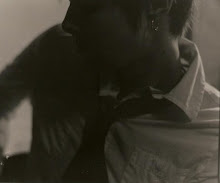[If this wouldn't be impressive enough without audio, I'm pretty sure that the song is by Ratatat. As if it could be any better.]
This next one is a little longer, and kind of anticlimactic... but is still worth watching the first couple of minutes and then fast-forward to the end product. This is a pulp-painting "print" of a Chuck Close painting. Basically, what "pulp-painting" is... Okay, let me explain a few things first. Paper is made from a pulp. It might help to think about it like orange juice - the kind labeled "extra pulp". If you were to put that orange juice through a strainer, the pulp, or orange FIBERS would be left behind when the water is drained from it, right? And when it dries out, it would become sort of like a solid surface. Paper is the same way - Its made from tiny fibers (like cotton, for example) which are strained through a mold, pressed and made flat, and then put through a drying system. When the fibers are interconnected, this creates a surface and, depending on how long or short those fibers are, this usually dictates how strong the paper will be. Short fibers are easier to tear, whereas long fibers (typical of traditional Eastern papers, specifically Japanese) are very strong. Pulp "PAINTING" is when the pulp is separated and colored with pure pigments, and these guys have come up with a system of using color coded bottles and stencils to produce a replica of a Chuck Close painting. Only, this is not a "painting", per say... but rather, it's simply just PAPER. VERY cool stuff.

No comments:
Post a Comment